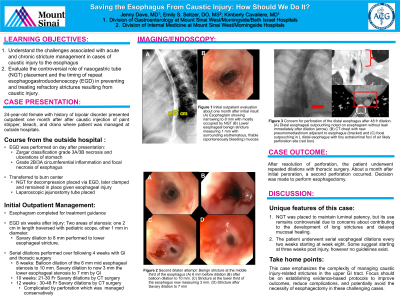Sunday Poster Session
Category: Esophagus
P0471 - Saving the Esophagus from Caustic Injury: How Should We Do It?
Sunday, October 22, 2023
3:30 PM - 7:00 PM PT
Location: Exhibit Hall


Emily S. Seltzer, DO, MS
Mount Sinai West and Morningside
New York, New York
Presenting Author(s)
Jenny Dave, MD, MS1, Emily S. Seltzer, DO, MS1, Kimberly Cavaliere, MD2
1Mount Sinai West and Morningside, New York, NY; 2Mount Sinai Morningside-West, New York, NY
Introduction: Caustic injury can cause significant damage to the upper gastrointestinal tract including stricture formation. Despite the severity of this condition, there are no comprehensive guidelines on acute and chronic stricture management. This leaves providers to trial and error, which may lead to further complications and need for an esophagectomy. We present a case of esophageal stricture formation and complications from caustic injury.
Case Description/Methods: A 24-year-old female presented to an outside hospital after ingesting paint stripper, bleach and Drano. CT Chest was without evidence of perforation. Within 24 hours she underwent EGD revealing Zargar classification Grade 2B/3A circumferential inflammation and focal necrosis of the esophagus and Grade 3A/3B necrosis and ulcerations in the stomach. A nasogastric tube (NGT) was placed and remained in place upon discharge for luminal patency. A J-tube was placed for nutrition. Her care was transferred to our institution three weeks later. She underwent repeat EGD 6 weeks after ingestion, revealing friable mucosa with two areas of benign-appearing stenosis in the mid and distal esophagus dilated with a Savary dilator to 35Fr, and removal of the NGT. Required serial dilations over the next four weeks with minimal improvement in stenosis. At 12 weeks, dilation was performed to 48Fr, resulting in an esophageal tear. CT Chest showed new pneumomediastinum and esophageal micro perforation. She was managed conservatively and repeat imaging showed resolution. She is planned for continued serial dilations.
Discussion: This case highlights the challenges of stricture prevention and management from caustic injury. NGT placement may be helpful to ensure the patency of the esophageal lumen. However, it is also known to contribute to the development of long strictures and delay mucosal healing, thus it’s use is controversial. It is unclear if the NGT had help prevent or cause the refractory strictures in our patient. Additionally, the timing of when to perform repeat EGD to prevent and/or treat strictures is uncertain. It is thought that strictures typically develop 8 weeks after ingestion (De Lusong, 2013). Conversely, an expert review notes dilation is usually done at 3 weeks as scar tissue is completely formed after 8 weeks (Methasate, 2018). There is a need for standardized guidelines to optimally manage caustic injury strictures. This may help prevent complications including perforation and possible esophagectomy when dilation outcomes are poor.
Disclosures:
Jenny Dave, MD, MS1, Emily S. Seltzer, DO, MS1, Kimberly Cavaliere, MD2. P0471 - Saving the Esophagus from Caustic Injury: How Should We Do It?, ACG 2023 Annual Scientific Meeting Abstracts. Vancouver, BC, Canada: American College of Gastroenterology.
1Mount Sinai West and Morningside, New York, NY; 2Mount Sinai Morningside-West, New York, NY
Introduction: Caustic injury can cause significant damage to the upper gastrointestinal tract including stricture formation. Despite the severity of this condition, there are no comprehensive guidelines on acute and chronic stricture management. This leaves providers to trial and error, which may lead to further complications and need for an esophagectomy. We present a case of esophageal stricture formation and complications from caustic injury.
Case Description/Methods: A 24-year-old female presented to an outside hospital after ingesting paint stripper, bleach and Drano. CT Chest was without evidence of perforation. Within 24 hours she underwent EGD revealing Zargar classification Grade 2B/3A circumferential inflammation and focal necrosis of the esophagus and Grade 3A/3B necrosis and ulcerations in the stomach. A nasogastric tube (NGT) was placed and remained in place upon discharge for luminal patency. A J-tube was placed for nutrition. Her care was transferred to our institution three weeks later. She underwent repeat EGD 6 weeks after ingestion, revealing friable mucosa with two areas of benign-appearing stenosis in the mid and distal esophagus dilated with a Savary dilator to 35Fr, and removal of the NGT. Required serial dilations over the next four weeks with minimal improvement in stenosis. At 12 weeks, dilation was performed to 48Fr, resulting in an esophageal tear. CT Chest showed new pneumomediastinum and esophageal micro perforation. She was managed conservatively and repeat imaging showed resolution. She is planned for continued serial dilations.
Discussion: This case highlights the challenges of stricture prevention and management from caustic injury. NGT placement may be helpful to ensure the patency of the esophageal lumen. However, it is also known to contribute to the development of long strictures and delay mucosal healing, thus it’s use is controversial. It is unclear if the NGT had help prevent or cause the refractory strictures in our patient. Additionally, the timing of when to perform repeat EGD to prevent and/or treat strictures is uncertain. It is thought that strictures typically develop 8 weeks after ingestion (De Lusong, 2013). Conversely, an expert review notes dilation is usually done at 3 weeks as scar tissue is completely formed after 8 weeks (Methasate, 2018). There is a need for standardized guidelines to optimally manage caustic injury strictures. This may help prevent complications including perforation and possible esophagectomy when dilation outcomes are poor.
Disclosures:
Jenny Dave indicated no relevant financial relationships.
Emily Seltzer indicated no relevant financial relationships.
Kimberly Cavaliere indicated no relevant financial relationships.
Jenny Dave, MD, MS1, Emily S. Seltzer, DO, MS1, Kimberly Cavaliere, MD2. P0471 - Saving the Esophagus from Caustic Injury: How Should We Do It?, ACG 2023 Annual Scientific Meeting Abstracts. Vancouver, BC, Canada: American College of Gastroenterology.
